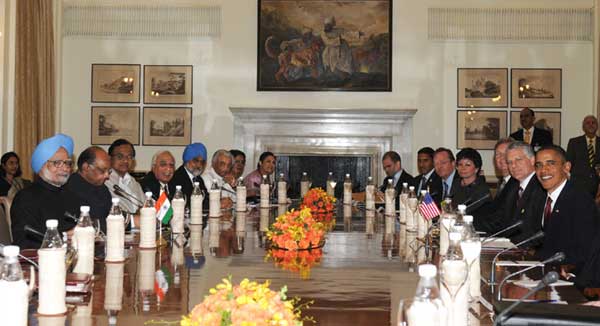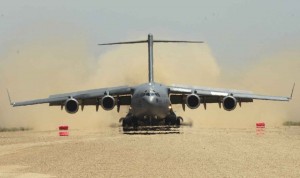The Light Utility Helicopter still in use throughout the Indian armed forces, the Chetak, began life as the French-designed Alouette. The aircraft was phased out by the French long ago but was manufactured in India under licence by HAL for many years. It is being phased out as the indigenous ALH has entered quantity production. Parenthetically, the Chetak was the subject of a negotiation with Israel that would have “unmanned” the helicopter for use primarily by the Indian Navy in a reconnaissance role similar to that of the US Navy’s Fire Scout. That idea has apparently been dropped.
Left to their own devices, the Indian uniformed services would opt for a level playing field for American hardware.
French success as a military supplier to India has depended heavily on the merchandising proclivities of a succession of French Presidents and Prime Ministers. President Sarkozy, for example, had made multiple visits to India with a principal aim of pressing the case of the Rafale fighter as the designated MMRCA. Dassault is now in the lead with the Rafale priced lower than the Typhoon. However, the contract is yet to be concluded.
Can US Companies Compete Successfully?
Left to their own devices, the Indian uniformed services would opt for a level playing field for American hardware. The IAF, for example, culminated an extended and unrequited love affair with the C-130 with the successful procurement of the aircraft delivered last year. The effort contended with the fact that civilians at the MoD and in other ministries ultimately control the procurement process where decisions are made with a weather eye toward political expediency as much as military need. The US contender won, in this case, because there simply was no other third country STOL transport that met the need. Similarly, the Boeing P-8 in the P-8I configuration fulfilled the Indian Navy’s ASW requirement when there was no effective alternative.
Savvy American companies have to an extent “broken the code” in approaching the Indian defence market.
On the contrary, a review of the MMRCA competition is instructive. Six international fighters adequately addressed the requirement. It appears that the down-select decision was made on the basis of not-clearly-discerned political considerations. Parenthetically, it will be interesting to see how the GOI justifies making the final choice of the most expensive competitor in apparent direct violation of the supposedly inviolable tenets of the Defence Procurement Procedure (DPP)! What is clear in the case of the F-16, is the inescapable fact that earlier models of that same aircraft than the one offered to India, remain among Pakistan’s first-line tactical aircraft fleet. Washington’s continuing involvement with military supply to Pakistan remains a negative for some of the smaller partners in the Congress-led current Indian administration as it was in the predecessor BJP regime. More recently, the waters may have been further muddied by informal suggestions that the USG make the fifth-generation F-35 Joint Strike Fighter available to India.
American defence contractors must contend with the ambivalence of senior Indians, in uniform and not, concerning the “reliability” of the US as a supplier. Though this view is waning, not so long ago it was the opener of every conversation on military transfers. There is the residual memory of three USG embargoes, two as a result of the 1965 and 1971 wars with Pakistan and a third following the Indian detonation of a nuclear device in 1998. More insidious perhaps is a sub-rosa anti-Americanism that still colours the thinking of some of the minority parties in the inevitable coalitions that govern India.
More pertinent and difficult to contend with is Indian resentment of the various constraints, the “fine print” that comes with acquisitions from American suppliers under the Arms Export Control Act (AECA) and other US legislative restrictions. Before India was once again approved for military transfers, the GOI was required to sign a General Security of Military Information Agreement (GSOMIA), which it did. As the relationship grew in the early 2000s, New Delhi was confronted with the requirements for end-user monitoring under which the USG reserved the right to physically inspect commodities transferred under the AECA in situ in the recipient country. Despite protestations from Washington that the right was seldom if ever exercised, the Indian legal community balked at having to formally accept this constraint as a requirement of arms transfers. The matter was settled in Solomon-like fashion by an exchange of diplomatic notes between the two governments that obviated the need for both signatures on a single document.
Indian balkiness in this context is founded in the fact that current Indian arms acquisitions from the US are funded exclusively with Indian monies. Indian officials acknowledge the “right” of the USG to insist on this documentation, however, where US Foreign Military Financing is involved (Read Pakistan).
The GOI is enervated by the protracted time it takes to secure clearance for US military sales, hastening to point out that American contractors must secure a licence just to respond to Indian requests for information and then, arrange for an export licence to complete the shipment of hardware once bought. No amount of argumentation that these constraints are not India-specific and apply to all purchasers of US military equipment lessens Indian consternation.
The current and several previous US administrations have recognised the impediments of the AECA-prescribed bureaucracy. Former Secretary of Defence Robert Gates formally directed a major effort to ameliorate the situation. Robert Gates left office, however, with very little to show for his directive since much of the putative corrective action would require legislative remedies.
…there is the matter of corruption. India’s procurement mechanism is no better and no worse than the international average in this respect.
American defence suppliers acknowledge these problems but contend to the Indian customer and to all other similarly frustrated potential customers that the leading edge technology, high quality and ironclad warranties inherent in US defence products are worth waiting for. This approach is, at best, a weak reed.
Savvy American companies have, to an extent, “broken the code” in approaching the Indian defence market. Where they have been successful, they have worked with the Indian military customer to tailor the statement of need for a particular system required by the DPP. If professionally done, Boeing’s effort on the P-8 is a good example. The RFI or RFP published on the Indian MoD’s official procurement website narrows the focus such that the requesting Indian service and the US supplier both get what they want.
Then there is the matter of corruption. India’s procurement mechanism is no better and no worse than the international average in this respect. The US Foreign Corrupt Practices Act and other legislative and regulatory constraints ensure that American contractors succumb to these blandishments at their own considerable peril. On the other side of the coin, notorious instances of corruption in the Indian procurement process, the lingering effects of the GOI’s procurement of 155mm Howitzers from Sweden’s Bofors comes immediately to mind as well as the much more recent Telecommunications Ministry scandal that landed the minister in jail, has somewhat levelled the playing field.
In summation, American defence suppliers realise that India is perhaps the largest potential market open to them in the world today. But so do all the competition. This is not a market in which to make a quick buck. India qualifies as a valid customer fulfilling the three essential requirements, namely demonstrable and active threats to its national security, an abiding interest in addressing and staying ahead of these threats with leading-edge technology and a reasonably sufficient exchequer to be able to respond to these threats. American suppliers to be successful in India must be there for the long haul, be extremely frustration-tolerant and recognise the absolute requirement to establish strong personal relationships in a culture that is sophisticated but significantly different from our own.







Col Gross provides a refreshing view of what is needed to get India into the big league of weapons systems production. He is candid in his assessment of India’s weakness in taking on design and development of complicated military hardware. Is that because of weak management capabilities or lack of advance technological skills. My guess is former, since India has proven time and again of being able to handle successfully space and nuclear projects which require advance technology wherewithal. To overcome the production management weakness, India needs to learn from the masters, namely, US and European private sectors engaged in high tech defense products. Joint co-production with such partners which include the Design and Development phase will accelerate learning and will be the most efficient use of the nation’s resources.
The author forgot to mention the most complicated and often difficult US military hardware export rules and regulations. These put off any buyer.
Also please do mention the sanctions US places on even non lethal items. Indian LCA model which was undergoing wind testing in US was impounded and held up for two years.
US is unable to sanction China which openly steals secret military hardware without paying a penny. US rather stays mute to that. All rules apply to money paying customers.
Perhaps the most successful Indian suppliers have been the public sector shipyards that now are producing the bulk of the surface combatants and support ships for the Indian Navy and the Indian Coast Guard.